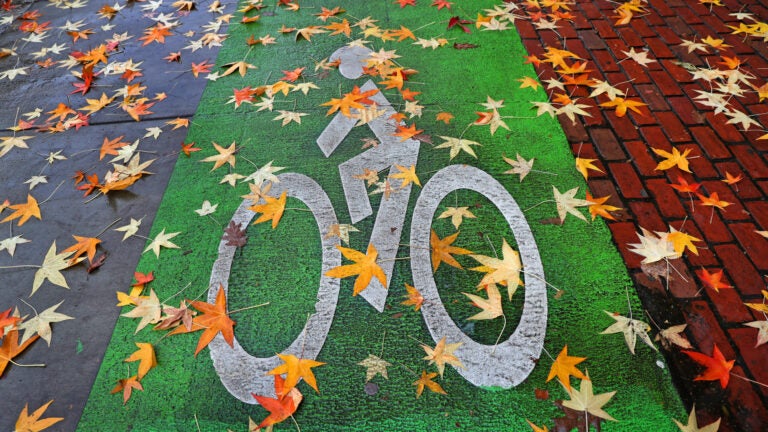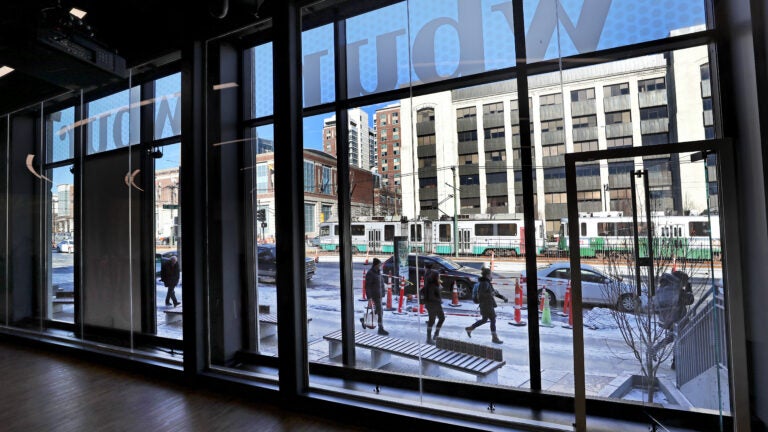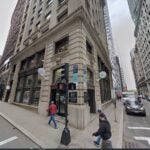What should Boston be doing to make the city safer for bicycles?
"If we invested in better alternatives, people would choose them."

Boston has recently hit a number of bike infrastructure milestones — a two-way bike path down the middle of the Causeway Street, traffic lights for cyclists, redesigned intersections, and even a bike rotary in Jamaica Plain — as the city works to create a safer network for cyclists.
Progress? Sure.
However, Becca Wolfson, the executive director of the Boston Cyclists Union, says the current efforts remain “anemic.”
“They might give a couple of people better access and a safer commute, but for most, you’re on nice bike facility for a very short period and then you’re thrown into dangerous conditions and chaos,” she told Boston.com.
And while Wolfson gives local officials some credit for long-anticipated projects to improve Comm. Ave. and the northern parts of Mass. Ave., “two of the highest crash corridors,” she says there’s a lot of unfinished work to improve treacherous intersections that many who rely on bikes as their regular mode of transportation are forced to take.
Last Friday, Meng Jin, a 24-year-old Boston University graduate student, was fatally struck by a dump truck at an intersection in front of the Museum of Science on the Boston-Cambridge line. Some regular cyclists told The Boston Globe in the immediate aftermath of the tragedy that they felt so unsafe traveling through that particular section that they either remained on the sidewalk or stopped biking all together.
I used to bike commute daily on this route and saw many near misses. I would arrive downtown so jangled by adrenalin that I had to stop. The chokepoint as O’Brien Hwy approaches Leverett Circle was, and remains, wildly hazardous.
— Tom Champion (@TChampMA) November 9, 2018
Wolfson says Meng was the 17th cyclist killed in Boston and Cambridge since 2011. And that doesn’t count all the serious nonfatal crashes, sideswipes, doorings, and near misses.
The Massachusetts Department of Transportation and the Department of Conservation and Recreation (DCR), which jointly manage the Charles River Dam Bridge stretch of O’Brien Highway, had committed to adding painted bike lanes last year. However, the plans were delayed due to concerns about “driver inconvenience,” Wolfson said.
But even the stalled plans — which called for four-to-five-foot bike lanes, the minimum recommended width — wouldn’t be enough, according to Wolfson.
“Paint does not protect people, especially on a highway,” she said. “Also, these are too narrow. To provide meaningful safety and comfort, there needs to be physical separation (protected bike lanes), and a wider dedicated space. This is one of a few Charles River bridge crossings, and all are critical links for commuters across the region.”
This image is from a @MassDOT official FAQ. It shows plans for bike lanes on this stretch, promised when #Longfellow construction finished. @MassDCR put a hold on striping due to fears of traffic delay for MVs. Road is 6-8 lanes wide, key bike route, no dedicated space for bikes pic.twitter.com/7BTaDXG0XU
— BostonCyclistsUnion (@bostonbikeunion) November 10, 2018
Boston city officials stress that there are a number of projects to expand “better bike lanes,” such as protected or physically separated lanes, especially on the most highly trafficked routes. The city estimated in 2017 that there are more than 40,000 bike trips per day in Boston.
Transit advocates are once again calling for officials to pick up the pace of their efforts.
In an opinion piece Thursday for the Globe, Wolfson, Boston City Councilor Michelle Wu, and Cambridge Vice Mayor Jan Devereux wrote that such “broken promises underscore the unconscionable cost of inaction in the face of community calls for safety interventions.” They noted that improvements — in some cases, minor — had been made at the Mass. Ave. and Beacon Street intersection, Inman Square, Porter Square, and Sullivan Square — only after cyclists had been killed at those locations.
“We need to prioritize lives over convenience,” they wrote.
Troy Wall, a DCR spokesman, says there’ll be a public meeting in mid-December about improving the area where Meng was killed.
“DCR and MassDOT are having conversations with multiple stakeholders to discuss roadway improvements for this very complex and tight intersection area, used by a high number of drivers, walkers, school groups and cyclists on a daily basis,” Wall told Boston.com in a statement.

The aftermath of the bike crash last Friday in front of the Museum of Science.
Under Mayor Tom Menino, Boston launched a comprehensive bike program, which included a plan to create a network of 195 miles of bike lanes by 2018. According to the city’s GoBoston 2030 mobility plan released in 2017, they’re still executing on that mission, but had only built 105 miles of bike lanes since 2008.
Some private developers have also pitched in, such as in the Seaport, where one firm installed parking-protected bike lanes along Seaport Boulevard. Wolfson says the city needs to take the lead.
“We can’t build a network with that sort of reactionary spending,” she told Boston.com. “We need a vision.”
Wolfson also said the lack of separated bike lanes along corridors connecting Boston’s job center with its southern neighborhoods, such as Blue Hill Avenue, Dorchester Avenue, and some stretches of Mass. Ave, is an “equity issue.”
“From Symphony Hall all the way to Dorchester, it’s really unsafe to bike,” she said.
In addition to closing the gaps in the city’s bike lane network, Wolfson says there are other ways to make streets safer for cyclists.
Noting that trucks have been involved in 11 of the 17 fatal cyclist crashes, she says it’s imperative to make trucks safer by equipping them with things like side guards and crossover mirrors. Much of that responsibility lies with private truck owners, according to Wolfson.
But she says it also lies with legislators. In 2014, Mayor Marty Walsh pushed through a “first of its kind” ordinance requiring all motor vehicles over 10,000 pounds to have side guards, convex mirrors, crossover mirrors, and blind-spot awareness decals. Local lawmakers also introduced legislation requiring trucks owned or contracted by the state to have those safety elements, but the bill did not pass before the session this summer.
Another safety issue is of course speed.
The Boston City Council just recently held a hearing on reducing city speed limits to 20 mph. Wolfson supports the thinking behind the effort, as well as the “neighborhood slow zones,” but says there needs to be more than just a change in the speed limit to get drivers to let up on the gas.
Boston already lowered the city’s speed limits from 30 mph to 25 mph two years ago. Wolfson says drivers won’t change their behavior unless the city makes infrastructure changes. She thinks the city is focusing on its neighborhood slow zones at the expense of wider arterial roads and more heavily trafficked streets where people are disproportionately hit.
“The wider a space cars are given to drive, the faster they will drive,” she said.
Wolfson’s solution is to narrow the motor vehicle lanes — which research shows results in less aggressive driving — and add more protected bike lanes. Even if it adds to urban traffic, she says it could be lessened by more people deciding to bike on the safer routes.
“If we invested in better alternatives, people would choose them,” she said.







